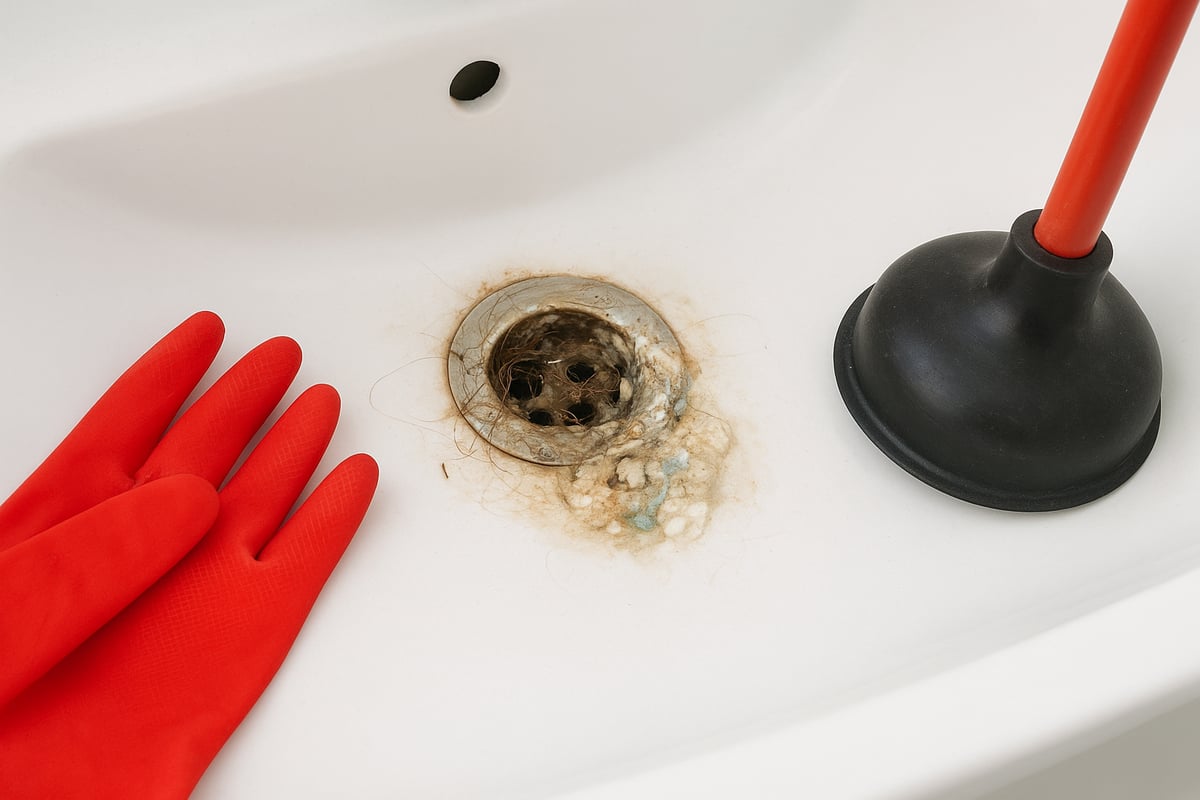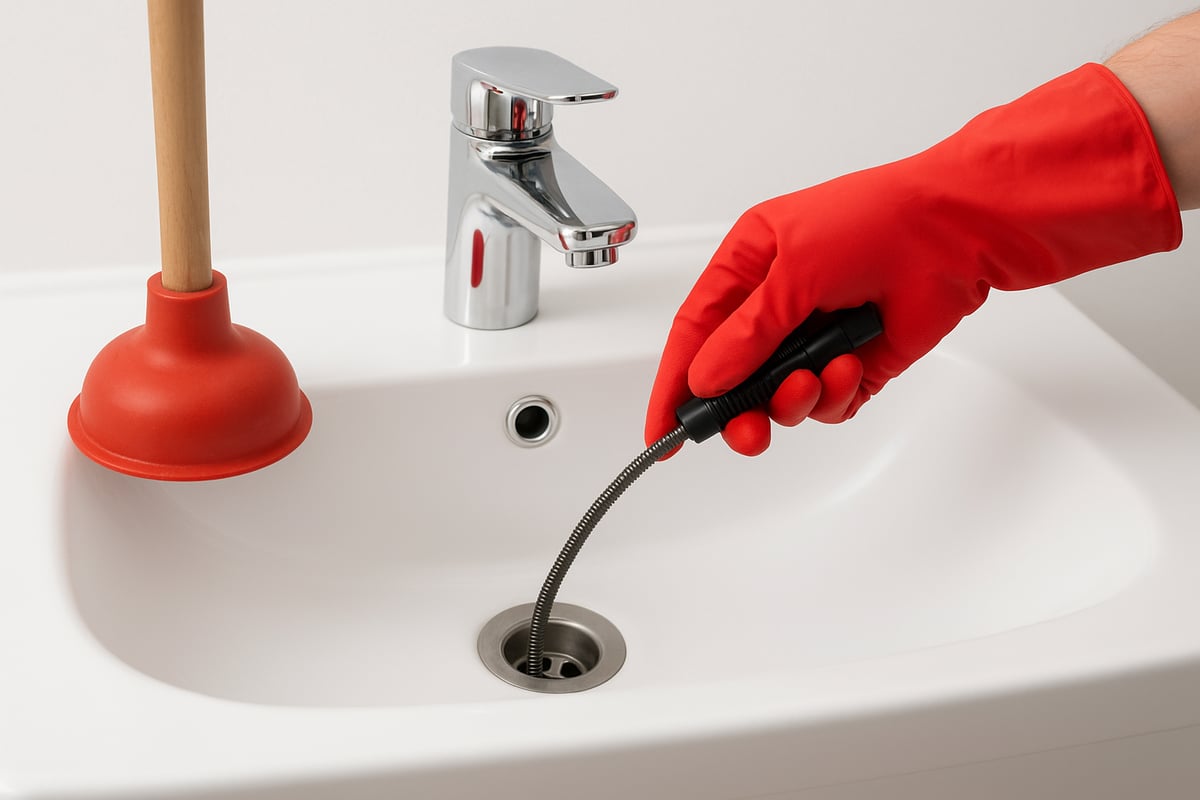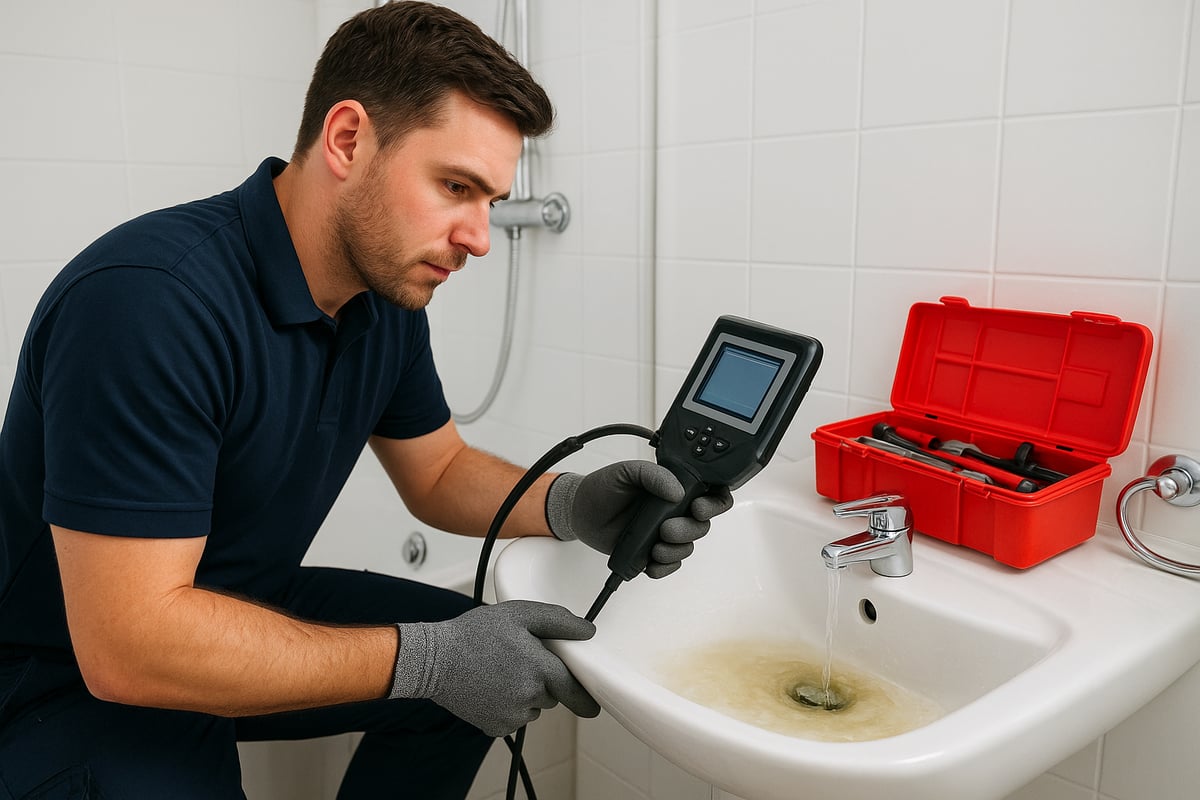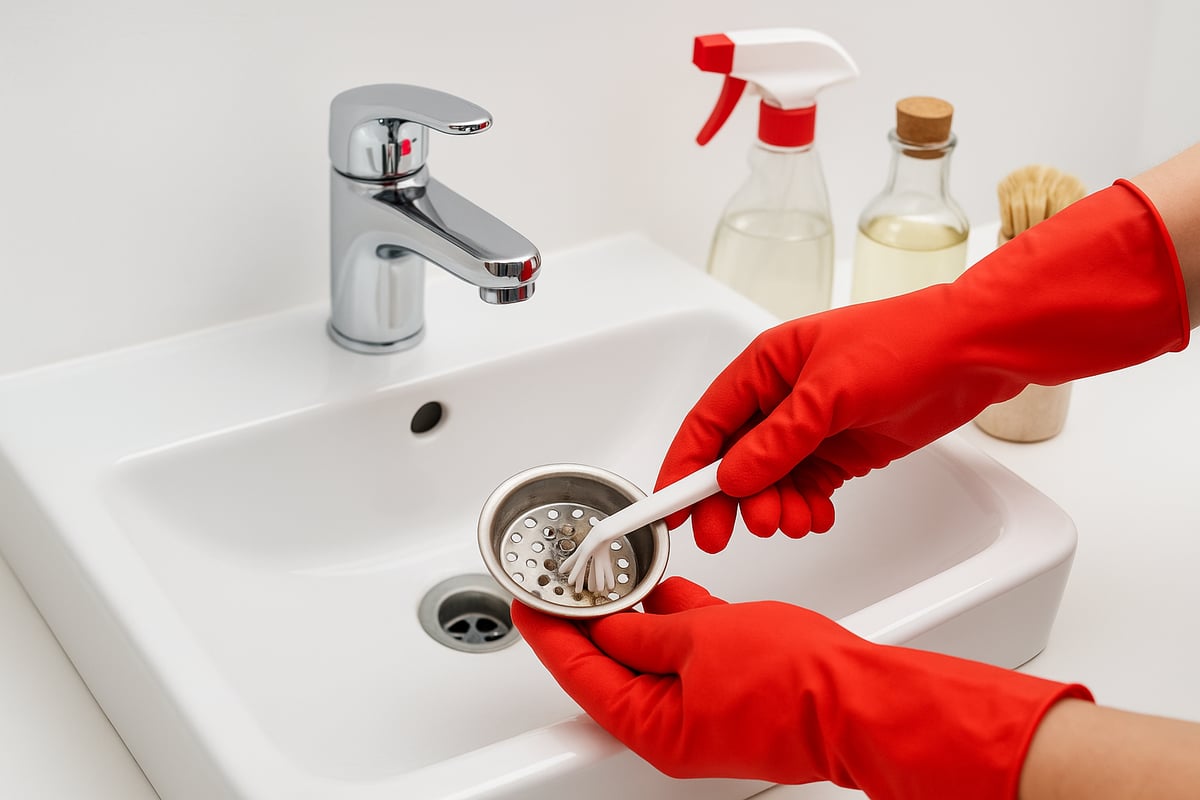Blocked Bathroom Sink Guide: Expert Solutions for 2025
A blocked bathroom sink can bring your morning routine to a standstill, causing stress when you least expect it, especially as plumbing systems evolve in 2025. Many UK households face this common inconvenience, but you do not have to let it disrupt your day. This guide shares expert, up-to-date methods for diagnosing, fixing, and preventing a blocked bathroom sink. Discover the main causes, step-by-step DIY fixes, when to call in the professionals, essential maintenance tips, and what the future holds for smarter sink care.
Understanding the Causes of a Blocked Bathroom Sink
A blocked bathroom sink can catch anyone off guard, quickly turning a peaceful morning routine into a stressful mess. Understanding the main causes of these blockages is essential for both quick fixes and long-term prevention. Let’s explore what commonly leads to a blocked bathroom sink, the early warning signs, and the potential impact on your home’s plumbing health.

Common Culprits Behind Sink Blockages
Most blocked bathroom sink issues are caused by a combination of everyday habits and unseen build-up. The biggest offenders? Hair and soap scum. According to a 2024 UK survey, over 60% of bathroom sink blockages are due to these two factors alone. When hair mixes with soap residue, it forms sticky clumps that easily lodge in the U-bend or trap.
Foreign objects can also contribute. Small items like jewellery, cotton buds, or even toothpaste caps may accidentally fall into the drain. In regions with hard water, such as Kent, mineral deposits and limescale can gradually narrow pipes, increasing the likelihood of a blocked bathroom sink.
Oils and grease from skincare products create another sticky layer inside the pipes, catching debris and worsening the problem. Outdated plumbing or poorly designed sinks, with sharp bends or narrow pipes, are more prone to frequent blockages.
For example, one Kent household experienced repeated blockages because their trap was installed at the wrong angle, causing debris to accumulate faster. If you’re facing persistent issues, consider seeking professional drainage services for blocked sinks to properly diagnose and clear stubborn blockages.
Early Warning Signs of a Blocked Sink
Spotting the signs of a blocked bathroom sink early can save you from a complete shutdown. The most common warning is slow draining water. If you notice water lingering in the basin longer than usual, it could signal a forming blockage.
Listen for gurgling sounds after using the tap. These noises mean trapped air is struggling to escape past a blockage. Unpleasant odours, usually a musty or rotten smell, often point to trapped organic matter breaking down in your pipes.
Water backing up into the basin is a more advanced warning, indicating a blockage is stopping normal flow. In one real-life scenario, a homeowner ignored these signs for weeks. Eventually, water overflowed onto the floor, causing avoidable water damage and an emergency callout.
If you observe any of these symptoms, take action immediately. Delaying can turn a minor blocked bathroom sink into a much bigger and costlier issue.
Impact of Blocked Sinks on Home Hygiene and Plumbing Health
A blocked bathroom sink is more than just a nuisance—it can have serious consequences for your home. When water cannot drain properly, it may overflow, leading to water damage on floors, cabinets, and walls. Persistent dampness encourages mould growth, which can harm your family’s health.
Blocked sinks put extra pressure on your plumbing system, sometimes causing leaks or even pipe bursts. Stagnant water in a blocked bathroom sink is also a breeding ground for bacteria and other germs, increasing your risk of illness.
In Kent, local data from 2023 shows that blocked sinks are among the top three reasons for emergency plumber callouts. Addressing the causes early protects both your plumbing and your household’s well-being.
Step-by-Step DIY Solutions for Unblocking a Bathroom Sink
A blocked bathroom sink can be a hassle, but with the right approach, most clogs can be cleared safely at home. This section walks you through practical, up-to-date DIY methods for unblocking your sink, ensuring you avoid common pitfalls and know when to call in the pros.

Essential Tools and Safety Precautions
Before tackling a blocked bathroom sink, gather the necessary tools and prioritise safety. Having the right kit not only speeds up the job but also helps prevent accidental damage or injury.
Essential tools:
- Plunger (cup-style is best for sinks)
- Manual drain snake or flexible wire
- Bucket (for catching water)
- Protective gloves
- Torch or headlamp for visibility
Safety tips:
- Always wear gloves to protect your hands from bacteria and sharp debris.
- Use eye protection if working with chemical cleaners.
- Ensure the room is well-ventilated, especially if using any cleaning chemicals.
- Avoid mixing different cleaning agents, which can create harmful fumes.
If you choose to use a chemical drain cleaner, always follow the manufacturer’s instructions. Never use boiling water on ceramic sinks, as it can cause cracking.
Step 1: Remove and Clean the Sink Stopper
Many blocked bathroom sink problems begin right at the stopper. Hair, soap, and grime often accumulate here, making it a key focus for your first step.
How to remove the stopper:
- Look under the sink for a pivot rod attached to the drainpipe.
- Unscrew the retaining nut and gently pull out the pivot rod.
- Lift the stopper from the basin.
Cleaning tips:
- Wipe away hair and debris using tissue or a brush.
- Rinse the stopper thoroughly before replacing it.
Stubborn build-up can be soaked in warm, soapy water for easier removal. Cleaning the stopper regularly is one of the simplest ways to prevent a blocked bathroom sink from recurring.
Step 2: Use a Plunger to Dislodge the Blockage
If cleaning the stopper does not solve your blocked bathroom sink, the next step is plunging. A plunger creates suction and pressure to break up the clog.
Proper plunging technique:
- Fill the sink with enough water to cover the plunger cup.
- Place the plunger over the drain, ensuring a tight seal.
- Push down and pull up sharply several times.
For best results, block any overflow holes with a wet cloth to maximise pressure. Plunging is most effective for partial blockages where water still drains slowly. If water remains stagnant, try several plunges before moving on.
Be patient, as it may take multiple attempts to shift stubborn debris. Avoid excessive force, which can damage seals or pipes.
Step 3: Try a Natural Drain Cleaner Solution
If your blocked bathroom sink persists, consider a natural cleaning solution. Many UK households prefer eco-friendly options for minor blockages.
Natural drain cleaner recipe:
- Pour half a cup of baking soda down the drain.
- Follow with one cup of white vinegar.
- Cover the drain and let the mixture fizz for 15–20 minutes.
- Flush with a kettle of hot (not boiling) water.
Effectiveness comparison:
| Method | Pros | Cons |
|---|---|---|
| Baking soda/vinegar | Eco-friendly, safe for pipes | May need repeated use |
| Commercial cleaner | Fast acting | Can be harsh, costly |
According to a 2024 UK survey, 45% of households use natural remedies for a blocked bathroom sink. These solutions are ideal for soft clogs caused by soap or toothpaste but may be less effective on solid obstructions.
Step 4: Deploy a Drain Snake or Wire Hanger
Sometimes, a blocked bathroom sink needs more direct action. A manual drain snake or even a straightened wire hanger can help break up deeper clogs.
How to use a drain snake:
- Insert the snake or wire into the drain, gently feeding it down.
- Rotate or wiggle to catch debris.
- Pull out slowly, removing any trapped material.
Take care not to force the tool, as pipes can be fragile. Many DIYers have successfully cleared long-standing blockages this way, especially when hair is the main culprit.
A homeowner in Kent reported that a simple wire hanger resolved her blocked bathroom sink after natural cleaners failed. Always clean tools thoroughly after use.
Step 5: Disassemble and Clean the U-Bend (Trap)
If the blockage remains, the U-bend (also called the trap) is often the source. Around 70% of persistent blocked bathroom sink issues are found here.
Instructions:
- Place a bucket under the U-bend to catch water.
- Unscrew the slip nuts by hand or with pliers.
- Carefully remove the trap and empty its contents.
- Rinse out the U-bend thoroughly, using a brush if needed.
Inspect for signs of corrosion or hardened deposits. Once clean, reassemble the trap, making sure all seals are tight. Test by running water and checking for leaks.
Regular trap cleaning is a powerful preventive measure against a blocked bathroom sink.
When to Avoid DIY Methods and Seek Professional Help
DIY solutions work for most minor cases, but some blocked bathroom sink problems require expert intervention.
Warning signs:
- Recurring blockages despite repeated attempts.
- Water leaks, corrosion, or foul odours from the plumbing.
- Water backing up into other fixtures, like the shower.
Using harsh chemicals or too much force may damage pipework. If you are unsure or the issue persists, it is wise to seek professional assistance. For more complex scenarios, General plumbing repairs and maintenance services can provide safe and effective solutions.
Professional plumbers use advanced tools and diagnostic techniques to resolve stubborn blocked bathroom sink issues quickly and safely.
When to Call a Professional: Recognising Complex Blockages
A blocked bathroom sink can go from a minor annoyance to a major headache if not addressed promptly. Sometimes, despite your best DIY efforts, the issue persists or worsens. Knowing when to call in a professional can save you time, money, and prevent further damage to your plumbing system.

Signs You Need Expert Assistance
Certain signs suggest your blocked bathroom sink is more than a simple clog. If you notice any of the following, it’s time to call a professional:
- Water drains slowly even after repeated attempts to clear the blockage.
- Persistent, foul odours linger around the sink, indicating deeper issues.
- Water backs up into the basin or leaks are visible under the sink.
- Gurgling sounds from the drain point to trapped air or major obstructions.
- Multiple fixtures, such as the sink and shower, show drainage problems at the same time.
Ignoring these symptoms can lead to more serious plumbing problems. For example, a Kent family noticed their blocked bathroom sink kept returning even after using natural cleaners and a plunger. The root cause turned out to be old, corroded pipes that needed professional replacement. Early intervention could have prevented water damage and extra repair costs.
If your blocked bathroom sink is causing water to pool on the floor or you spot mould growth nearby, act quickly. Delaying professional help increases the risk of leaks, pipe bursts, and costly repairs. Watch for these warning signs to protect your home’s hygiene and plumbing health.
What to Expect from a Professional Plumber
When you call a professional for a blocked bathroom sink, you can expect a thorough and efficient service. Plumbers use advanced diagnostic tools such as CCTV drain surveys and pressure testing to pinpoint the exact cause of the blockage. This approach ensures the problem is fully resolved, not just temporarily fixed.
Professional plumbers are equipped with high-pressure jetting machines and motorised drain snakes, allowing them to clear tough blockages that DIY methods cannot handle. If your home has outdated or damaged pipework, they can recommend appropriate upgrades to prevent future issues.
Here’s a quick comparison of typical professional services for a blocked bathroom sink in 2024:
| Service | Average Cost (UK) | Typical Timeframe |
|---|---|---|
| Standard unblocking | £80–£120 | 30–60 minutes |
| CCTV drain survey | £100–£200 | 1–2 hours |
| Pipe repair or replacement | £150–£500 | 2–4 hours |
It’s essential to choose a Gas Safe registered and insured professional for your blocked bathroom sink. This ensures all work is carried out safely and meets UK standards. If you’re unsure when to call for help, the Emergency plumber and gas engineer guide explains the situations where expert intervention is critical.
By recognising these signs and knowing what to expect, you can resolve your blocked bathroom sink quickly and avoid further disruption to your daily routine.
Preventing Future Blockages: Maintenance and Best Practices
Keeping your bathroom in top shape means staying ahead of any blocked bathroom sink issues. Prevention is always easier than dealing with a full blockage. By adopting a few simple habits and making smart upgrades, you can keep your sink flowing freely all year round.

Daily and Weekly Sink Care Routines
Routine care is your first line of defence against a blocked bathroom sink. After brushing teeth or washing hands, take a quick look for hair or debris and remove it before it goes down the drain. Using a sink strainer can catch most solids, making daily cleaning much easier.
Every week, flush your sink with hot water to help prevent soap scum and residue build-up. This keeps the pipes clear and reduces the risk of a blocked bathroom sink forming over time.
- Clear hair and debris after each use
- Use a strainer to trap solids
- Flush with hot water weekly
These habits only take a few seconds but can make a huge difference in keeping your bathroom running smoothly.
Monthly Deep Cleaning and Inspection
A monthly deep clean is vital to stop a blocked bathroom sink from sneaking up on you. Start by removing the sink stopper and cleaning it thoroughly. Check for any sticky residue or trapped hair.
Next, use a natural cleaner like baking soda and vinegar, followed by hot water. Inspect under the sink for signs of leaks or early build-up. Keeping a lookout for these warning signs can help you catch problems before they turn into a blocked bathroom sink emergency.
| Task | Recommended Tools |
|---|---|
| Stopper cleaning | Old toothbrush, gloves |
| Drain cleaning | Baking soda, vinegar |
| Leak inspection | Torch, kitchen roll |
By sticking to this monthly routine, you stay one step ahead of major issues.
Avoiding Common Mistakes That Cause Blockages
Many blocked bathroom sink problems start with small mistakes. Never pour grease, oils, or coffee grounds down your bathroom sink. These substances can solidify and cling to the pipes.
Avoid flushing items that won’t dissolve, such as dental floss, cotton pads, or even hair ties. These items can quickly lead to a blocked bathroom sink, especially in older plumbing systems.
- Don’t pour grease or oils down the sink
- Never flush non-dissolvable items
- Teach everyone in your home these rules
A simple slip-up can lead to an expensive plumbing callout, so keep these tips in mind.
Plumbing Upgrades and Modern Solutions
Modernising your plumbing reduces the risk of a blocked bathroom sink. Consider installing a new U-bend with an anti-blockage design. Water softeners are a smart investment in hard water areas like Kent, as they prevent limescale build-up.
Smart technology is also making its way into bathrooms. Sensors can alert you to slow drainage before a blocked bathroom sink occurs, saving you time and hassle.
| Upgrade | Benefit |
|---|---|
| Modern U-bend | Easier cleaning, fewer clogs |
| Water softener | Reduces limescale |
| Smart sensors | Early blockage alerts |
These upgrades can help future-proof your plumbing.
Education and Family Involvement
Getting everyone on board is crucial to preventing a blocked bathroom sink. Teach children and guests what should and shouldn’t go down the drain. Simple reminders, like a note near the sink, can help reinforce good habits.
Hold a quick family meeting or send a message explaining the importance of preventing a blocked bathroom sink. The more everyone knows, the fewer problems you’ll face.
- Discuss proper sink use with family and guests
- Post reminders in shared bathrooms
- Share cleaning routines with everyone
Teamwork makes keeping your bathroom blockage-free much easier.
Data-Driven Preventive Measures
Recent data shows that households using regular maintenance routines are far less likely to experience a blocked bathroom sink. According to UK plumbing industry statistics 2024, over 65% of plumbing callouts in the UK could have been prevented with better sink care.
Professional plumbers agree that prevention is the best cure. The most effective strategies include using strainers, monthly deep cleans, and investing in modern plumbing solutions. Following these evidence-backed tips will help you keep a blocked bathroom sink at bay for years to come.
The Future of Bathroom Sink Maintenance: Trends and Innovations for 2025
The world of bathroom plumbing is rapidly evolving, with new technologies and smarter solutions on the horizon. Homeowners facing a blocked bathroom sink in 2025 will benefit from innovations that make maintenance easier, greener, and more effective than ever before. Let's explore the trends shaping the future of sink care.
Emerging Plumbing Technologies
Smart sinks are making waves in UK homes. Features like self-cleaning cycles, blockage alerts, and water usage tracking are now built into premium models. AI-driven systems can predict when a blocked bathroom sink is likely, sending notifications to your phone before issues occur.
Eco-friendly drain cleaners and enzymatic solutions are replacing harsh chemicals, reducing environmental impact and pipe damage. According to the World Plumbing Council April 2024 review, global advancements in plumbing tech are driving more sustainable and preventative maintenance practices.
Sustainable Practices and Products
Sustainability is at the heart of modern sink maintenance. Biodegradable cleaning agents are now widely available, offering effective solutions for a blocked bathroom sink without harming the environment. Households are also embracing methods that conserve water, such as targeted cleaning and using minimal product.
Products like reusable drain traps and water-saving taps are gaining popularity. These innovations not only address blockages but also help reduce household waste, keeping maintenance both green and cost-effective.
Regulatory Changes and Standards
In 2025, new UK regulations are set to influence how we deal with a blocked bathroom sink. Updated plumbing standards will require better drainage systems and the use of certified eco-safe products in new builds and renovations.
Homeowners and landlords must stay informed about these changes to ensure compliance. These regulations are designed to improve water efficiency, reduce blockages, and protect public health across the country.
Professional Services: Evolving Standards
Plumbing professionals are adapting quickly to these innovations. Many now use smart diagnostic tools and offer training on the latest maintenance techniques. For persistent or complex blocked bathroom sink problems, experts employ high-tech solutions like CCTV drain surveys and hydro-jetting.
The plumbing and heating profession stability report highlights how the industry remains robust, with ongoing investment in training and technology to meet rising homeowner expectations.
Consumer Trends and Expectations
UK homeowners are increasingly prioritising eco-friendly and tech-enabled plumbing products. Surveys show that 60% plan to invest in smart solutions for a blocked bathroom sink by 2025. People want devices that offer convenience, early warnings, and easy maintenance.
Expectations are shifting towards seamless integration with home automation systems. This trend is pushing manufacturers to innovate and make sink care smarter, safer, and more efficient for all households.
Case Study: A Smart Bathroom Sink in a Modern Kent Home
In Kent, one family recently upgraded to a smart bathroom sink. The system detected early signs of a blocked bathroom sink, triggered a self-cleaning cycle, and sent a maintenance reminder to their phone.
As a result, they experienced fewer blockages, reduced water use, and spent less time on manual cleaning. Their experience highlights how embracing innovation can transform everyday home maintenance and prevent future headaches.
If you’ve tried the step by step fixes but still find your bathroom sink struggling with stubborn blockages or slow drainage, don’t worry—you’re not alone These plumbing issues can be tricky, especially with modern sinks and the hard water we get here in Kent Sometimes, calling in a trusted expert is the best move for peace of mind and lasting results With over 20 years of experience and a friendly team of Gas Safe registered engineers, Castle Heating Kent is ready to help you get your bathroom back to normal Feel free to Call Now on 01634790511 or 0800 0016511 for honest advice or fast support

